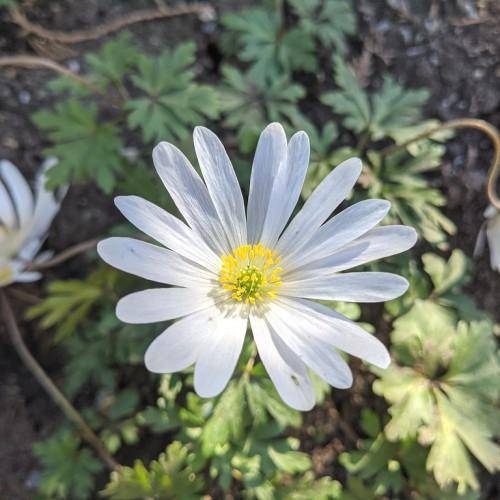
windflower
Anemone blanda
Also Known As - blue wood anemoneCycle:
Perennial
Watering:
Average
Hardiness Zone:
5 - 8
Flowers:
Flowers
Sun:
full sun,part shade
Soil:
Humus rich, Well-drained
Fruits:
Fruits In Spring Ready In Spring
Leaf:
Yes
Growth Rate:
Low
Maintenance:
Low
Drought Tolerant:
Yes
Salt Tolerant:
Yes
Care Level:
Easy
watering
Water the Windflower once a week, in the amount of 1/2 to 1 inch, depending on conditions. Make sure the soil is damp but not soaked. If the soil dries out, water the Windflower deeply so the water can reach the roots. If the plant shows any signs of stress, let the soil dry out slightly before watering again.
sunlight
Windflower (Anemone blanda) is a plant species that thrives best in full sunlight, but can handle some light shade. It needs at least 6 hours of direct sunlight per day during its growing season, which is typically in the spring and summer months. During the winter, it should be exposed to as much natural light as possible, even in cooler climates where the sun may not be as strong.
pruning
Windflower (Anemone blanda) should be pruned after blooming, generally from May to July. Pruning should be done to remove old flower stalks and any dead or damaged foliage. Cut the foliage and flower stalks back to the soil level. This encourages strong new growth, and a new round of blooms. Pruning can also be done in the fall, to cut back any overgrown foliage.
Propagation
Season
Hardiness Map
FAQ
Is the wind flower hardy plant?
Yes, the wind flower is a hardy plant that is known for its ability to withstand extreme weather conditions. It can be found growing in areas with low temperatures, high winds, and periods of drought. It is also a tough plant that is tolerant of abuse from people and animals. With adequate amounts of sun and water, the wind flower can thrive in any landscape.
Can windflower tolerate wild drought?
Yes, windflowers (Anemone acutiloba) are quite tolerant of drought conditions. The plant's root system is quite deep, enabling it to reach down to water sources even during long periods of little or no rainfall. Not only is it tolerant of drought, but windflower is also highly resistant to most pests and disease. It is often referred to as a “tough beauty” for its ability to withstand harsh climates as well as its bold and lush appearance.
Are windflowers easy to grow from seed?
Yes, windflowers, or Anemone blanda, are relatively easy to grow from seed. They are native to grassland habitats in Europe and the Mediterranean, which makes them accustomed to growing in well-drained, lightly-fertilized soils. It is often recommended to sow windflower seeds directly onto the soil, where they should be kept moist in warmer climates. They are a relatively low-maintenance plant, requiring little water and light pruning, and they can make spectacular additions to any garden.
Could windflowers be grown in containers?
Yes, windflowers can be grown in containers. Planting the seeds indoors in a sunny spot and then transplanting your windflowers to containers once the seedlings are about 3 inches tall is a great way to get your container windflower garden started. Windflowers do best when grown in well-drained soil and should be watered regularly. Fertilize and trim your container windflowers as needed, taking care to deadhead them regularly so they will keep producing blooms throughout the season. To protect your windflowers in the winter, either move the container indoors or invest in a winter heating blanket. With proper care, your container windflower garden can flourish year-round.
Can windflowers be used as cut flowers?
Yes, windflowers can be used as cut flowers. They have delicate five-petaled crepe-textured flowers in shades of white, pink, or purple. While they are mostly grown as a potted plant, they can be cut and used as a suitable option for flower bouquets and other decorations. Windflowers will make more of an impact when you group them together with other blooming elements.
How long do windflowers typically bloom?
Windflowers, also known as Anemones, typically bloom from late spring to early summer, last around 4 to 6 weeks. The exact time of bloom may vary depending on weather conditions, but will usually last from mid-April to mid-June. Some varieties may also flower for a second time in late summer or even into the autumn months.
Do windflowers have a strong fragrant?
Windflowers (Anemone blanda) are not known for their fragrant. They are small flowers, with a bell-shaped bloom which typically come in shades of blue, pink, white, and purples. Although windflowers aren't known for a strong scent, it has been said that when grown in groups windflowers can give off a pleasant smell with a hint of citrus. They are charming flowers that look beautiful when grown in the garden and are lovely to admire, however, if you are looking for a strongly fragrant flower, a windflower is not ideal.
Should windflowers be planted in the fall or spring?
Windflowers should be planted in the spring. While they may be able to survive if planted in the fall, they will experience much better growth and hardiness in the spring months when temperatures are warmer and soil is easier to work with. Since windflowers are typically hardy, they can be planted in spring as early as the last frost date, which allows them to take advantage of the spring rains which will help them to become established without having to be heavily watered by hand.
